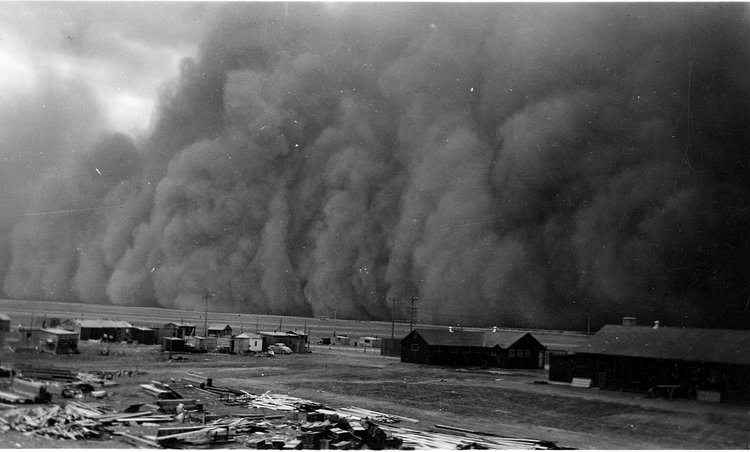In the simplest terms, drought is the absence of water over an extended period of time. There are different ways drought can occur, and for this reason, there are four different definitions of drought. Drought is something that happens slowly, and as “persistent and abnormal moisture deficiency” [1] continues, ecosystems, people and the economy can be adversely impacted.
Environment Canada defines drought as a “sustained and regionally extensive occurrence of appreciably below-average natural water availability in the form of precipitation, streamflow, or groundwater” [2].
The Government of Alberta (GoA) has not adopted a specific definition of drought and acknowledges that no one single definition works in all circumstances. However, in the context of the GoA’s Alberta’s Agriculture Drought Risk Management Plan (ADRM), drought is defined as “an extended period of below-normal precipitation resulting in decreased soil and subsoil moisture levels and diminished surface water supplies affecting crop growth, livestock water or irrigation water” [3].

Drought is a natural occurrence that is part of the climate cycle. Drought can develop in any region and can last for a varying length of time: anywhere from a matter of weeks (“flash droughts”) to decades [4].
There are four classifications of drought. All of these drought types can occur simultaneously, but they can also occur independently of one another.
Meteorological drought usually comes before other forms of drought, and is a result of less precipitation than normal over a prolonged period in a specific region. Meteorological drought can begin and end quickly, or it can continue on for a longer period of time.
Agricultural drought occurs when there is not enough soil moisture to meet the needs of crops. Agricultural drought is usually the next type of drought to occur after meteorological drought. Agricultural drought can occur without affecting water supply for other uses, such as municipal drinking water.
Hydrological drought occurs when lake, river, reservoir or groundwater supplies fall to below average levels due to a lack of precipitation. Hydrological drought occurs much more slowly than meteorological and/or agricultural drought, as it depletes water that is stored but not easily replenished.
Socioeconomic drought occurs when the prolonged absence of water in a region begins to impact people and the economy.
Drought is caused by a lack of precipitation in a region over a prolonged period of time. However, a lack of precipitation may not always result in a drought.
Drought is a result of a combination of several factors.
Not only must there be a lack of precipitation, but the timing, distribution and intensity of this lack of precipitation must be severe enough to result in a drought. Even at this point a drought may not occur; if there is sufficient water storage (e.g. in reservoirs) and water demand is properly managed, drought may be averted [5].
Although droughts are natural occurrences, human activity can aggravate the severity of a drought. For example, drought can become more severe if it occurs in an area where there is high water demand and limited water supply, or in areas where water is managed inadequately (e.g. over-allocation of a body of water) or specific land-use practices (e.g. agriculture) impact the ability of ecosystems to replenish water supplies.
Drought is a natural weather occurrence. Scientists have been able to determine how often drought has occurred in the past by analyzing tree ring data. The study and analysis of tree ring data in Alberta has allowed researchers to understand historical river flows in the years preceding the mid-1850s, when streamflow was not measured.
Looking back, historical records show there is an approximate 60 year weather cycle (see picture below). This weather cycle is a result of the Pacific Decadal Oscillation, a pattern of variability in the Pacific Ocean which affects precipitation and streamflow.
The connection between climate change, loss of Arctic ice and extreme weather events is an area of active research in the scientific community. However, what is clear is that there are natural weather cycles that result in drier and wetter periods. According to Dr. Dave Sauchyn, a leading expert in tree ring analysis, “for the foreseeable future, regional climate regimes will be dominated by natural variability, especially where it is characteristically high, as in western Canada for example” [6].
In 2012, the Intergovernmental Panel on Climate Change (IPCC) published the report, “Managing the Risks of Extreme Events and Disasters to Advance Climate Change Adaptation”, which synthesized existing research on climate change. One of the IPCC’s conclusions was that it was unclear whether climate change is making droughts worse [7]. Although a clear connection between climate change and an increase in severity, a connection between duration or frequency of droughts is yet to be made despite information from historical records on natural weather cycles. While the IPCC report did not show a connection between climate change and drought, more recent work has concluded that the atmospheric conditions responsible for California’s current drought (one of the worst in the state’s history) are “very likely” connected to human-induced climate change [8].
Although a clear connection between climate change and an increase in drought severity, duration, and/or frequency is yet to be made, recent work has made the case for this connection. For example, a 2014 study concluded that the atmospheric conditions responsible for California’s current drought (one of the worst in the state’s history) are “very likely” connected to human induced climate change.
We provide Canadian educational resources on water practices to promote conservation and sustainability. Our team crafts current and relevant content, while encouraging feedback and engagement.
The Canada WaterPortal is a registered charity, #807121876RR0001
We recognize and respect the sovereignty of the Indigenous Peoples and communities on whose land our work takes place.
© 2025 All Rights Reserved.